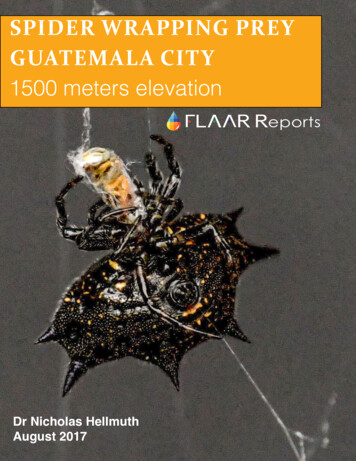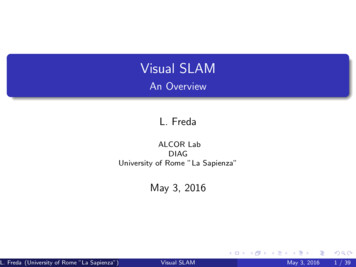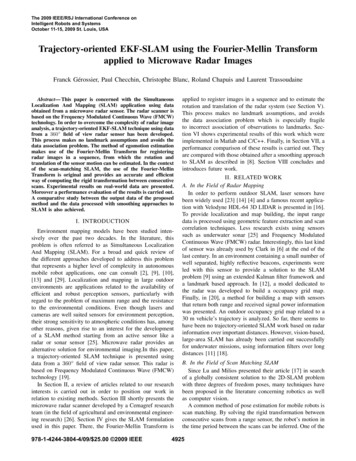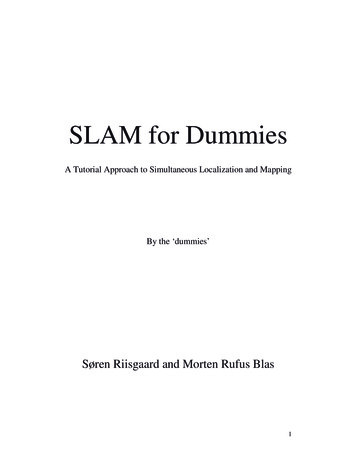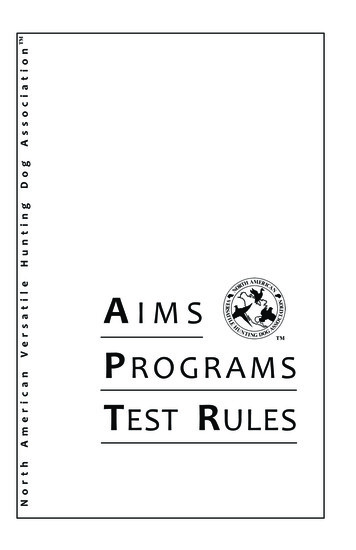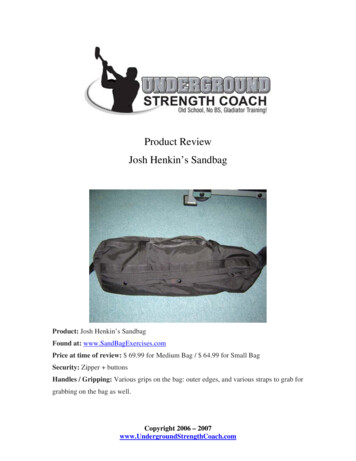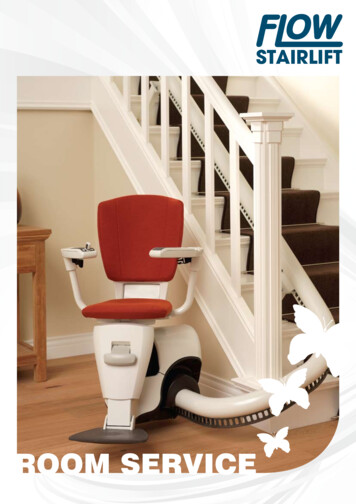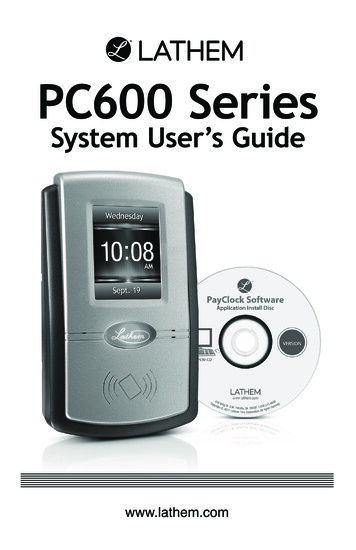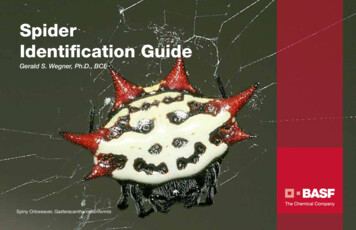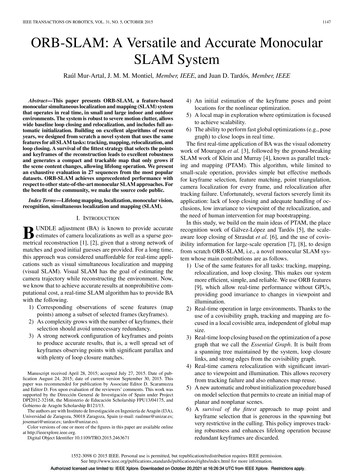
Transcription
IEEE TRANSACTIONS ON ROBOTICS, VOL. 31, NO. 5, OCTOBER 20151147ORB-SLAM: A Versatile and Accurate MonocularSLAM SystemRaúl Mur-Artal, J. M. M. Montiel, Member, IEEE, and Juan D. Tardós, Member, IEEEAbstract—This paper presents ORB-SLAM, a feature-basedmonocular simultaneous localization and mapping (SLAM) systemthat operates in real time, in small and large indoor and outdoorenvironments. The system is robust to severe motion clutter, allowswide baseline loop closing and relocalization, and includes full automatic initialization. Building on excellent algorithms of recentyears, we designed from scratch a novel system that uses the samefeatures for all SLAM tasks: tracking, mapping, relocalization, andloop closing. A survival of the fittest strategy that selects the pointsand keyframes of the reconstruction leads to excellent robustnessand generates a compact and trackable map that only grows ifthe scene content changes, allowing lifelong operation. We presentan exhaustive evaluation in 27 sequences from the most populardatasets. ORB-SLAM achieves unprecedented performance withrespect to other state-of-the-art monocular SLAM approaches. Forthe benefit of the community, we make the source code public.Index Terms—Lifelong mapping, localization, monocular vision,recognition, simultaneous localization and mapping (SLAM).I. INTRODUCTIONUNDLE adjustment (BA) is known to provide accurateestimates of camera localizations as well as a sparse geometrical reconstruction [1], [2], given that a strong network ofmatches and good initial guesses are provided. For a long time,this approach was considered unaffordable for real-time applications such as visual simultaneous localization and mapping(visual SLAM). Visual SLAM has the goal of estimating thecamera trajectory while reconstructing the environment. Now,we know that to achieve accurate results at nonprohibitive computational cost, a real-time SLAM algorithm has to provide BAwith the following.1) Corresponding observations of scene features (mappoints) among a subset of selected frames (keyframes).2) As complexity grows with the number of keyframes, theirselection should avoid unnecessary redundancy.3) A strong network configuration of keyframes and pointsto produce accurate results, that is, a well spread set ofkeyframes observing points with significant parallax andwith plenty of loop closure matches.BManuscript received April 28, 2015; accepted July 27, 2015. Date of publication August 24, 2015; date of current version September 30, 2015. Thispaper was recommended for publication by Associate Editor D. Scaramuzzaand Editor D. Fox upon evaluation of the reviewers’ comments. This work wassupported by the Dirección General de Investigación of Spain under ProjectDPI2012-32168, the Ministerio de Educación Scholarship FPU13/04175, andGobierno de Aragón Scholarship B121/13.The authors are with Instituto de Investigación en Ingenierı́a de Aragón (I3A),Universidad de Zaragoza, 50018 Zaragoza, Spain (e-mail: raulmur@unizar.es;josemari@unizar.es; tardos@unizar.es).Color versions of one or more of the figures in this paper are available onlineat http://ieeexplore.ieee.org.Digital Object Identifier 10.1109/TRO.2015.24636714) An initial estimation of the keyframe poses and pointlocations for the nonlinear optimization.5) A local map in exploration where optimization is focusedto achieve scalability.6) The ability to perform fast global optimizations (e.g., posegraph) to close loops in real time.The first real-time application of BA was the visual odometrywork of Mouragon et al. [3], followed by the ground-breakingSLAM work of Klein and Murray [4], known as parallel tracking and mapping (PTAM). This algorithm, while limited tosmall-scale operation, provides simple but effective methodsfor keyframe selection, feature matching, point triangulation,camera localization for every frame, and relocalization aftertracking failure. Unfortunately, several factors severely limit itsapplication: lack of loop closing and adequate handling of occlusions, low invariance to viewpoint of the relocalization, andthe need of human intervention for map bootstrapping.In this study, we build on the main ideas of PTAM, the placerecognition work of Gálvez-López and Tardós [5], the scaleaware loop closing of Strasdat et al. [6], and the use of covisibility information for large-scale operation [7], [8], to designfrom scratch ORB-SLAM, i.e., a novel monocular SLAM system whose main contributions are as follows.1) Use of the same features for all tasks: tracking, mapping,relocalization, and loop closing. This makes our systemmore efficient, simple, and reliable. We use ORB features[9], which allow real-time performance without GPUs,providing good invariance to changes in viewpoint andillumination.2) Real-time operation in large environments. Thanks to theuse of a covisibility graph, tracking and mapping are focused in a local covisible area, independent of global mapsize.3) Real-time loop closing based on the optimization of a posegraph that we call the Essential Graph. It is built froma spanning tree maintained by the system, loop closurelinks, and strong edges from the covisibility graph.4) Real-time camera relocalization with significant invariance to viewpoint and illumination. This allows recoveryfrom tracking failure and also enhances map reuse.5) A new automatic and robust initialization procedure basedon model selection that permits to create an initial map ofplanar and nonplanar scenes.6) A survival of the fittest approach to map point andkeyframe selection that is generous in the spawning butvery restrictive in the culling. This policy improves tracking robustness and enhances lifelong operation becauseredundant keyframes are discarded.1552-3098 2015 IEEE. Personal use is permitted, but republication/redistribution requires IEEE permission.See http://www.ieee.org/publications standards/publications/rights/index.html for more information.Authorized licensed use limited to: IEEE Xplore. Downloaded on October 20,2021 at 16:26:34 UTC from IEEE Xplore. Restrictions apply.
1148IEEE TRANSACTIONS ON ROBOTICS, VOL. 31, NO. 5, OCTOBER 2015We present an extensive evaluation in popular public datasetsfrom indoor and outdoor environments, including hand-held,car, and robot sequences. Notably, we achieve better cameralocalization accuracy than the state of the art in direct methods [10], which optimize directly over pixel intensities insteadof feature reprojection errors. We include a discussion in Section IX-B on the possible causes that can make feature-basedmethods more accurate than direct methods.The loop closing and relocalization methods here presentedare based on our previous work [11]. A preliminary version ofthe system was presented in [12]. In the current paper, we addthe initialization method, the Essential Graph, and perfect allmethods involved. We also describe in detail all building blocksand perform an exhaustive experimental validation.To the best of our knowledge, this is the most complete andreliable solution to monocular SLAM, and for the benefit of thecommunity, we make the source code public. Demonstrationvideos and the code can be found in our project webpage.1II. RELATED WORKA. Place RecognitionThe survey by Williams et al. [13] compared several approaches for place recognition and concluded that techniquesbased on appearance, that is, image-to-image matching, scalebetter in large environments than map-to-map or image-tomap methods. Within appearance-based methods, bags of wordstechniques [14], such as the probabilistic approach FAB-MAP[15], are to the fore because of their high efficiency. DBoW2 [5]used for the first time bags of binary words obtained from BRIEFdescriptors [16] along with the very efficient FAST feature detector [17]. This reduced in more than one order of magnitudethe time needed for feature extraction, compared with SURF[18] and SIFT [19] features that were used in bags of wordsapproaches so far. Although the system demonstrated to be veryefficient and robust, the use of BRIEF, neither rotation nor scaleinvariant, limited the system to in-plane trajectories and loop detection from similar viewpoints. In our previous work [11], weproposed a bag of words place recognizer built on DBoW2 withORB [9]. ORB are binary features invariant to rotation and scale(in a certain range), resulting in a very fast recognizer with goodinvariance to viewpoint. We demonstrated the high recall androbustness of the recognizer in four different datasets, requiringless than 39 ms (including feature extraction) to retrieve a loopcandidate from a 10 K image database. In this study, we use animproved version of that place recognizer, using covisibility information and returning several hypotheses when querying thedatabase instead of just the best match.B. Map InitializationMonocular SLAM requires a procedure to create an initialmap because depth cannot be recovered from a single image.One way to solve the problem is to initially track a knownstructure [20]. In the context of filtering approaches, points can1 http://webdiis.unizar.es/ raulmur/orbslambe initialized with high uncertainty in depth using an inversedepth parameterization [21], which hopefully will later convergeto their real positions. The recent semidense work of Engelet al. [10] follows a similar approach initializing the depth ofthe pixels to a random value with high variance.Initialization methods from two views either assume locallyscene planarity [4], [22] and recover the relative camera posefrom a homography using the method of Faugeras and Lustman[23], or compute an essential matrix [24], [25] that models planar and general scenes, using the five-point algorithm of Nistér[26], which requires to deal with multiple solutions. Both reconstruction methods are not well constrained under low parallaxand suffer from a twofold ambiguity solution if all points of aplanar scene are closer to one of the camera centers [27]. On theother hand, if a nonplanar scene is seen with parallax, a uniquefundamental matrix can be computed with the eight-point algorithm [2], and the relative camera pose can be recovered withoutambiguity.In Section IV, we present a new automatic approach basedon model selection between a homography for planar scenesand a fundamental matrix for nonplanar scenes. A statisticalapproach to model selection was proposed by Torr et al. [28].Under a similar rationale, we have developed a heuristic initialization algorithm that takes into account the risk of selectinga fundamental matrix in close to degenerate cases (i.e., planar,nearly planar, and low parallax), favoring the selection of thehomography. In the planar case, for the sake of safe operation,we refrain from initializing if the solution has a twofold ambiguity, as a corrupted solution could be selected. We delay theinitialization until the method produces a unique solution withsignificant parallax.C. Monocular Simultaneous Localization and MappingMonocular SLAM was initially solved by filtering [20], [21],[29], [30]. In that approach, every frame is processed by the filter to jointly estimate the map feature locations and the camerapose. It has the drawbacks of wasting computation in processingconsecutive frames with little new information and the accumulation of linearization errors. On the other hand, keyframe-basedapproaches [3], [4] estimate the map using only selected frames(keyframes) allowing to perform more costly but accurate BAoptimizations, as mapping is not tied to frame rate. Strasdatet al. [31] demonstrated that keyframe-based techniques aremore accurate than filtering for the same computational cost.The most representative keyframe-based SLAM system isprobably PTAM by Klein and Murray [4]. It was the first workto introduce the idea of splitting camera tracking and mappingin parallel threads and demonstrated to be successful for realtime augmented reality applications in small environments. Theoriginal version was later improved with edge features, a rotation estimation step during tracking, and a better relocalizationmethod [32]. The map points of PTAM correspond to FAST corners matched by patch correlation. This makes the points onlyuseful for tracking but not for place recognition. In fact, PTAMdoes not detect large loops, and the relocalization is based onthe correlation of low-resolution thumbnails of the keyframes,yielding a low invariance to viewpoint.Authorized licensed use limited to: IEEE Xplore. Downloaded on October 20,2021 at 16:26:34 UTC from IEEE Xplore. Restrictions apply.
MUR-ARTAL et al.: ORB-SLAM: A VERSATILE AND ACCURATE MONOCULAR SLAM SYSTEMStrasdat et al. [6] presented a large-scale monocular SLAMsystem with a front-end based on optical flow implemented on aGPU, followed by FAST feature matching and motion-only BA,and a back-end based on sliding-window BA. Loop closureswere solved with a pose graph optimization with similarity constraints [7 degrees of freedom (DoF)], which was able to correctthe scale drift appearing in monocular SLAM. From this work,we take the idea of loop closing with 7-DoF pose graph optimization and apply it to the Essential Graph defined in Section III-D.Strasdat et al. [7] used the front-end of PTAM, but performedthe tracking only in a local map retrieved from a covisibilitygraph. They proposed a double-window optimization back-endthat continuously performs BA in the inner window and posegraph in a limited-size outer window. However, loop closing isonly effective if the size of the outer window is large enoughto include the whole loop. In our system, we take advantageof the excellent ideas of using a local map based on covisibility and building the pose graph from the covisibility graph,but apply them in a totally redesigned front-end and back-end.Another difference is that, instead of using specific features forloop detection (SURF), we perform the place recognition on thesame tracked and mapped features, obtaining robust frame-raterelocalization and loop detection.Pirker et al. [33] proposed CD-SLAM, i.e., a very completesystem including loop closing, relocalization, large-scale operation, and efforts to work on dynamic environments. However,map initialization is not mentioned. The lack of a public implementation does not allow us to perform a comparison ofaccuracy, robustness, or large-scale capabilities.The visual odometry of Song et al. [34] uses ORB featuresfor tracking and a temporal sliding window BA back-end. Incomparison, our system is more general as they do not haveglobal relocalization, loop closing, and do not reuse the map.They are also using the known distance from the camera to theground to limit monocular scale drift.Lim et al. [25], work published after we submitted our preliminary version of this work [12], use also the same features fortracking, mapping, and loop detection. However, the choice ofBRIEF limits the system to in-plane trajectories. Their systemonly tracks points from the last keyframe; therefore, the map isnot reused if revisited (similar to visual odometry) and has theproblem of growing unbounded. We compare qualitatively ourresults with this approach in Section VIII-E.The recent work of Engel et al. [10], known as LSD-SLAM, isable to build large-scale semidense maps, using direct methods(i.e., optimization directly over image pixel intensities) insteadof BA over features. Their results are very impressive as thesystem is able to operate in real time, without GPU acceleration, building a semidense map, with more potential applications for robotics than the sparse output generated by featurebased SLAM. Nevertheless, they still need features for loop detection, and their camera localization accuracy is significantlylower than in our system and PTAM, as we show experimentally in Section VIII-B. This surprising result is discussed inSection IX-B.In a halfway between direct and feature-based methods is thesemidirect visual odometry SVO of Forster et al. [22]. With-1149out requiring to extract features in every frame, they are ableto operate at high frame rates obtaining impressive results inquadracopters. However, no loop detection is performed, andthe current implementation is mainly thought for downwardlooking cameras.Finally, we want to discuss about keyframe selection. Allvisual SLAM works in the literature agree that running BA withall the points and all the frames is not feasible. The work ofStrasdat et al. [31] showed that the most cost-effective approachis to keep as much points as possible, while keeping onlynonredundant keyframes. The PTAM approach was to insertkeyframes very cautiously to avoid an excessive growth of thecomputational complexity. This restrictive keyframe insertionpolicy makes the tracking fail in hard exploration conditions.Our survival of the fittest strategy achieves unprecedented robustness in difficult scenarios by inserting keyframes as quicklyas possible, and removing later the redundant ones, to avoid theextra cost.III. SYSTEM OVERVIEWA. Feature ChoiceOne of the main design ideas in our system is that the samefeatures used by the mapping and tracking are used for placerecognition to perform frame-rate relocalization and loop detection. This makes our system efficient and avoids the need to interpolate the depth of the recognition features from near SLAMfeatures as in previous works [6], [7]. We require features thatneed for extraction much less than 33 ms per image, whichexcludes the popular SIFT ( 300 ms) [19], SURF ( 300 ms)[18], or the recent A-KAZE ( 100 ms) [35]. To obtain generalplace recognition capabilities, we require rotation invariance,which excludes BRIEF [16] and LDB [36].We chose ORB [9], which are oriented multiscale FAST corners with a 256-bit descriptor associated. They are extremelyfast to compute and match, while they have good invariance toviewpoint. This allows us to match them with wide baselines,boosting the accuracy of BA. We already shown the good performance of ORB for place recognition in [11]. While our currentimplementation makes use of ORB, the techniques proposed arenot restricted to these features.B. Three Threads: Tracking, Local Mapping, andLoop ClosingOur system, see an overview in Fig. 1, incorporates threethreads that run in parallel: tracking, local mapping, and loopclosing. The tracking is in charge of localizing the camera withevery frame and deciding when to insert a new keyframe. Weperform first an initial feature matching with the previous frameand optimize the pose using motion-only BA. If the tracking islost (e.g., due to occlusions or abrupt movements), the placerecognition module is used to perform a global relocalization.Once there is an initial estimation of the camera pose and featurematchings, a local visible map is retrieved using the covisibilitygraph of keyframes that is maintained by the system [seeFig. 2(a) and (b)]. Then, matches with the local map points areAuthorized licensed use limited to: IEEE Xplore. Downloaded on October 20,2021 at 16:26:34 UTC from IEEE Xplore. Restrictions apply.
1150IEEE TRANSACTIONS ON ROBOTICS, VOL. 31, NO. 5, OCTOBER 2015Fig. 1. ORB-SLAM system overview, showing all the steps performed by thetracking, local mapping, and loop closing threads. The main components of theplace recognition module and the map are also shown.searched by reprojection, and camera pose is optimized againwith all matches. Finally, the tracking thread decides if a newkeyframe is inserted. All the tracking steps are explained in detail in Section V. The novel procedure to create an initial mapis presented in Section IV.The local mapping processes new keyframes and performs local BA to achieve an optimal reconstruction in the surroundingsof the camera pose. New correspondences for unmatched ORBin the new keyframe are searched in connected keyframes inthe covisibility graph to triangulate new points. Some time aftercreation, based on the information gathered during the tracking, an exigent point culling policy is applied in order to retainonly high quality points. The local mapping is also in chargeof culling redundant keyframes. We explain in detail all localmapping steps in Section VI.The loop closing searches for loops with every new keyframe.If a loop is detected, we compute a similarity transformationthat informs about the drift accumulated in the loop. Then, bothsides of the loop are aligned and duplicated points are fused.Finally, a pose graph optimization over similarity constraints [6]is performed to achieve global consistency. The main novelty isthat we perform the optimization over the Essential Graph, i.e.,a sparser subgraph of the covisibility graph which is explainedin Section III-D. The loop detection and correction steps areexplained in detail in Section VII.We use the Levenberg–Marquardt algorithm implemented ing2o [37] to carry out all optimizations. In the Appendix, wedescribe the error terms, cost functions, and variables involvedin each optimization.C. Map Points, Keyframes, and Their SelectionEach map point pi stores the following:1) its 3-D position Xw ,i in the world coordinate system;2) the viewing direction ni , which is the mean unit vector of all its viewing directions (the rays that joinFig. 2. Reconstruction and graphs in the sequence f r3 longof f ice household from the TUM RGB-D Benchmark [38]. (a) Keyframes(blue), current camera (green), map points (black, red), current local map points(red). (b) Covisibility graph. (c) Spanning tree (green) and loop closure (red).(d) Essential graph.the point with the optical center of the keyframes thatobserve it);3) a representative ORB descriptor Di , which is the associated ORB descriptor whose hamming distance is minimum with respect to all other associated descriptors in thekeyframes in which the point is observed;4) the maximum dm ax and minimum dm in distances at whichthe point can be observed, according to the scale invariance limits of the ORB features.Each keyframe Ki stores the following:1) the camera pose Tiw , which is a rigid body transformation that transforms points from the world to the cameracoordinate system;2) the camera intrinsics, including focal length and principalpoint;3) all the ORB features extracted in the frame, associated ornot with a map point, whose coordinates are undistortedif a distortion model is provided.Map points and keyframes are created with a generous policy,while a later very exigent culling mechanism is in charge ofdetecting redundant keyframes and wrongly matched or nottrackable map points. This permits a flexible map expansionduring exploration, which boost tracking robustness under hardconditions (e.g., rotations, fast movements), while its size isbounded in continual revisits to the same environment, i.e.,lifelong operation. Additionally, our maps contain very fewoutliers compared with PTAM, at the expense of containingless points. Culling procedures of map points and keyframesare explained in Sections VI-B and VI-E, respectively.Authorized licensed use limited to: IEEE Xplore. Downloaded on October 20,2021 at 16:26:34 UTC from IEEE Xplore. Restrictions apply.
MUR-ARTAL et al.: ORB-SLAM: A VERSATILE AND ACCURATE MONOCULAR SLAM SYSTEMD. Covisibility Graph and Essential GraphCovisibility information between keyframes is very useful inseveral tasks of our system and is represented as an undirectedweighted graph as in [7]. Each node is a keyframe, and an edgebetween two keyframes exists if they share observations of thesame map points (at least 15), being the weight θ of the edgethe number of common map points.In order to correct a loop, we perform a pose graph optimization [6] that distributes the loop closing error along thegraph. In order not to include all the edges provided by the covisibility graph, which can be very dense, we propose to buildan Essential Graph that retains all the nodes (keyframes), butless edges, still preserving a strong network that yields accurateresults. The system builds incrementally a spanning tree fromthe initial keyframe, which provides a connected subgraph ofthe covisibility graph with minimal number of edges. When anew keyframe is inserted, it is included in the tree linked tothe keyframe which shares most point observations, and whena keyframe is erased by the culling policy, the system updatesthe links affected by that keyframe. The Essential Graph contains the spanning tree, the subset of edges from the covisibilitygraph with high covisibility (θm in 100), and the loop closureedges, resulting in a strong network of cameras. Fig. 2 shows anexample of a covisibility graph, spanning tree, and associatedessential graph. As shown in the experiments of Section VIII-E,when performing the pose graph optimization, the solution isso accurate that an additional full BA optimization barely improves the solution. The efficiency of the essential graph andthe influence of the θm in is shown at the end of Section VIII-E.E. Bags of Words Place RecognitionThe system has embedded a bags of words place recognition module, based on DBoW22 [5], to perform loop detectionand relocalization. Visual words are just a discretization of thedescriptor space, which is known as the visual vocabulary. Thevocabulary is created offline with the ORB descriptors extractedfrom a large set of images. If the images are general enough, thesame vocabulary can be used for different environments gettinga good performance, as shown in our previous work [11]. Thesystem builds incrementally a database that contains an invertindex, which stores for each visual word in the vocabulary, inwhich keyframes it has been seen, so that querying the databasecan be done very efficiently. The database is also updated whena keyframe is deleted by the culling procedure.Because there exists visual overlap between keyframes, whenquerying the database, there will not exist a unique keyframewith a high score. The original DBoW2 took this overlappinginto account, adding up the score of images that are close in time.This has the limitation of not including keyframes viewing thesame place but inserted at a different time. Instead, we groupthose keyframes that are connected in the covisibility graph.In addition, our database returns all keyframe matches whosescores are higher than the 75% of the best score.2 https://github.com/dorian3d/DBoW21151An additional benefit of the bags of words representation forfeature matching was reported in [5]. When we want to computethe correspondences between two sets of ORB features, we canconstraint the brute force matching only to those features thatbelong to the same node in the vocabulary tree at a certain level(we select the second out of six), speeding up the search. We usethis trick when searching matches for triangulating new points,and at loop detection and relocalization. We also refine thecorrespondences with an orientation consistency test (see [11]for details) that discards outliers ensuring a coherent rotationfor all correspondences.IV. AUTOMATIC MAP INITIALIZATIONThe goal of the map initialization is to compute the relativepose between two frames to triangulate an initial set of mappoints. This method should be independent of the scene (planar or general) and should not require human intervention toselect a good two-view configuration, i.e., a configuration withsignificant parallax. We propose to compute in parallel two geometrical models: a homography assuming a planar scene anda fundamental matrix assuming a nonplanar scene. We then usea heuristic to select a model and try to recover the relative posewith a specific method for the selected model. Our method onlyinitializes when it is certain that the two-view configuration issafe, detecting low-parallax cases and the well-known twofoldplanar ambiguity [27], avoiding to initialize a corrupted map.The steps of our algorithm are as follows.1) Find initial correspondences: Extract ORB features (onlyat the finest scale) in the current frame Fc and search formatches xc xr in the reference frame Fr . If not enoughmatches are found, reset the reference frame.2) Parallel computation of the two models: Compute in parallel threads a homography Hcr and a fundamental matrixFcr asxc Hcr xr ,xTc Fcr xr 0(1)with the normalized DLT and eight-point algorithms, respectively, as explained in [2] inside a RANSAC scheme.To make homogeneous the procedure for both models,the number of iterations is prefixed and the same for bothmodels, along with the points to be used at each iteration:eight for the fundamental matrix, and four of them forthe homography. At each iteration, we compute a scoreSM for each model M (H for the homography, F for thefundamental matrix) ρM d2cr (xic , xir , M )SM iρM (d2 ) ρM (d2r c xic , xir , M ) Γ d2 , if d2 TM0,if d2 TM(2)where d2cr and d2r c are the symmetric transfer errors [2]from one frame to the other. TM is the outlier rejectionthreshold based on the χ2 test at 95% (TH 5.99,TF 3.84, assuming a standard deviation of 1 pixel inAuthorized licensed use limited to: IEEE Xplore. Downloaded on October 20,2021 at 16:26:34 UTC from IEEE Xplore. Restrictions apply.
1152IEEE TRANSACTIONS ON ROBOTICS, VOL. 31, NO. 5, OCTOBER 2015the measurement error). Γ is defined equal to TH so thatboth models score equally for the same d in their inlierregion, again to make the process homogeneous.We keep the homography and fundamental matrix withthe highest score. If no model could be found (not enoughinliers), we restart the process again from step 1.3) Model selection: If the scene is planar, nearly planar orthere is low parallax, it can be explained by a homography.However, a fundamental matrix can also be found, but theproblem is not well constrained [2], and any attempt torecover the motion from the fundamental matrix wouldyield wrong results. We should select the homography asthe reconstruction method will correctly initialize from aplane or it will detect
reliable solution to monocular SLAM, and for the benefit of the community, we make the source code public. Demonstration videos and the code can be found in our project webpage.1 II. RELATED WORK A. Place Recognition The survey by Williams et al. [13] compared several ap-pro
